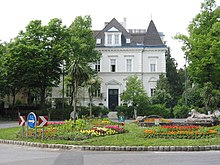Richard-Kralik-Platz
The Richard-Kralik-Platz is an octagonal space facility on the border of Vienna's municipal districts Währing and Döbling . It was named after the writer and philosopher Richard Kralik (1852–1934). The square is at the intersection between Weimarer Straße and Hasenauerstraße .
Street history
The square in Währinger and Döblinger Cottage was named Carl-Ludwig-Platz on September 20, 1881 . Planned from 1900 and implemented financially and organizationally by a committee under Gustav Tschermak (1836–1927), from 1906 an Archduke Karl Ludwig (1833–1896), brother of Emperor Franz Joseph I , was on the square in the middle of the large octagon . , dedicated monumental fountain made by Edmund Hofmann von Aspernburg (1847–1930) including obelisk and medallion picture, ceremoniously unveiled on October 8, 1906 by Archduke Rainer (1827–1913). Due to later border shifts, it was located on the border line separating Währing and Döbling, and was added to the majority of its area Währing ( KG Währing ). In 1920 it was renamed Weimarer Platz , in 1934, after the death of Richard Kralik, it was finally renamed. Richard Kralik had house No. 3 built here according to the plans of his father-in-law Wilhelm von Flattich (1826–1900), in which he also died.
particularities
The monumental fountain system suffered bomb damage in World War II and was subsequently torn down. In its place, Robert Ullmann (1903–1966) built the natural stone sculpture Two Children with a Turtle in 1954 . There are also two villas built by the chief architect of the cottage association Karl Ritter von Borkowski (1829–1905) from 1889 on the square .
From 1903 to 1960 the tram (from 1907: line 40) crossed the square (in single-track operation: north of the central island). Due to the slope of the Hasenauerstraße, the fall of leaves, carelessness, but also brake failure, there were always dangerous situations here (as in other parts of the steep section). The tram operation was taken over on November 14, 1960 by the bus route 40A.
literature
- Felix Czeike : Historical Lexicon Vienna. Volume 4: Le - Ro. Kremayr & Scheriau, Vienna 2004, ISBN 3-218-00748-8 .
- Wolfgang Czerny (arrangement): Vienna X. to XIX. and XXI. to XXIII. District. In: Dehio manual. The art monuments of Austria. Anton Schroll & Co, Vienna 1996, ISBN 3-7031-0693-X .
photos
Demolished: Richard-Kralik-Platz 4, Oberdöbling, Villa Eugenie Wolff , built 1896–97 by Hermann Müller and Albert Hans Pecha . (See also:, 1923)
Web links
- The stork on the tram. In: Neues Montagblatt mit Sport vom Sonntag , No. 25/1924 (XXI. Year), June 23, 1924, p. 2, center right. (Online at ANNO ). .
Individual evidence
- ↑ Czerny: Dehio-Handbuch , p. 486.
- ^ Carl-Ludwig-Platz (18, 19) in the Vienna History Wiki of the City of Vienna
- ↑ Daily news. (...) Carl Ludwig monument. In: Das Vaterland , Morgenblatt, No. 94/1901, April 6, 1901, p. 3, bottom center. (Online at ANNO ). .
- ^ The unveiling of the Archduke Karl Ludwig monument. In: Neue Freie Presse , Abendblatt, No. 15133/1906, October 8, 1906, p. 6, bottom right, f. (Online at ANNO ). .
-
↑ a b Local report. (...) Damage to a villa from an uncoupled tram. In: Neue Freie Presse , Morgenblatt, No. 20948/1923, January 4, 1923, p. 7, top right. (Online at ANNO ). ;
Little chronicle. (...) Tram accident in Währing. In: Neue Freie Presse , Abendblatt, No. 22639/1927, September 26, 1927, p. 4, center left. (Online at ANNO ). . -
↑ From Monday to bus service on line 40 . In: Arbeiter-Zeitung . Vienna November 13, 1960, p. 7 ( berufer-zeitung.at - the open online archive - digitized). as well as
this is what the new tramway looks like . In: Arbeiter-Zeitung . Vienna November 15, 1960, p. 5 ( Arbeiter-zeitung.at - the open online archive - digitized). - ↑ To our supplements. (…) No. 22. In: Wiener Bauindustrie-Zeitung , year 1891, No. 12/1891 (IX. Year), p. 114 (main part). (Online at ANNO ). .
- ^ Villa Eugenie Wolff, Vienna, XIX. Hasenauerstrasse 18. In: Wiener Bauindustrie-Zeitung , year 1899, No. 20/1899 (XVI. Year), p. 147 (main part). (Online at ANNO ). .
- ↑ Hermann Müller. In: Architects Lexicon Vienna 1770–1945. Published by the Architekturzentrum Wien . Vienna 2007.
- ^ Albert Hans Pecha. In: Architects Lexicon Vienna 1770–1945. Published by the Architekturzentrum Wien . Vienna 2007.
Remarks
- ↑ On the half left: to Türkenschanzpark rising towards Hasenauerstraße that, except for between March 19, 1907 and November 13, 1960 passing places , single-track streetcar traffic had. A double-track implementation was refused in 1903 by the Vienna City Council due to a disfigurement of the Währingen cottage district . - See: Communal-Zeitung. The electric tram line through the Währinger Cottageviertel. In: Neue Freie Presse , Morgenblatt, No. 13856/1903, March 24, 1903, p. 7, top center. (Online at ANNO ). .
-
↑ At the address Karl-Ludwig-Straße 62 built on behalf of the kk Bergrath and professor of the mining academy Příbram Franz Pošepný (1836–1895), who retired in the same year . - See :( Part :): Franz Pošepný. In: Neue Freie Presse , Morgenblatt, No. 10988/1895, March 28, 1895, p. 15. (Online at ANNO ). and
E (lisabeth) Lebensaft : Pošepný, Franz (1836–1895), mining engineer. In: Austrian Biographical Lexicon 1815–1950 (ÖBL). Volume 8, Verlag der Österreichischen Akademie der Wissenschaften, Vienna 1983, ISBN 3-7001-0187-2 , p. 219.
Coordinates: 48 ° 14 ′ 1 ″ N , 16 ° 20 ′ 38 ″ E





